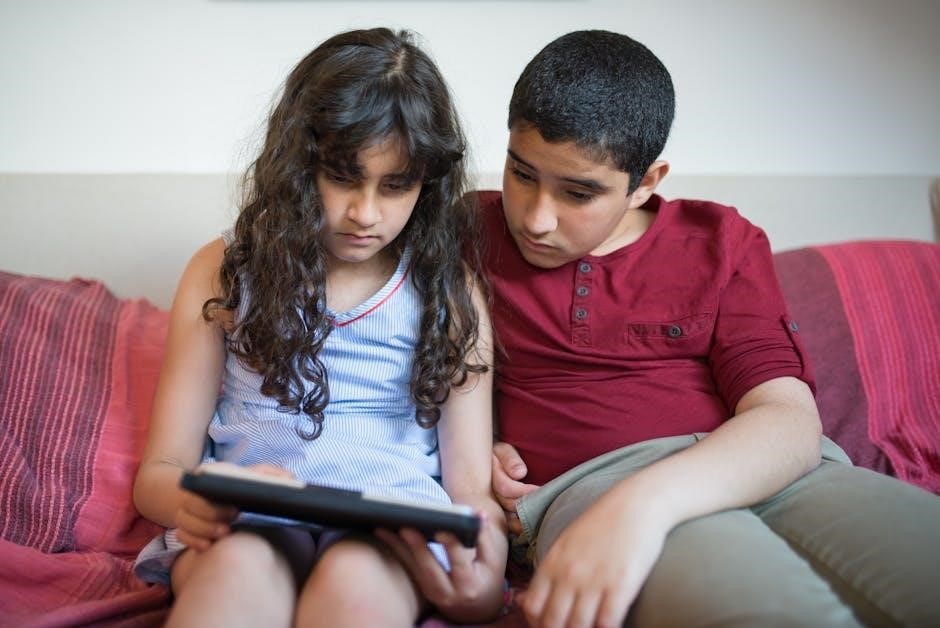Instructional technology and media for learning, as explored by Sharon Smaldino, focus on integrating technology to enhance teaching and learning experiences through strategies like the ASSURE model.

The Evolution of Instructional Technology
The evolution of instructional technology reflects significant advancements in how educators deliver and students receive information. Early developments focused on audio-visual tools like films and projectors, laying the groundwork for more complex systems. The rise of computers in the 20th century revolutionized learning, introducing mainframe systems and later personal computers. The internet further transformed the field, enabling e-learning platforms and online resources. Smaldino highlights how these innovations shifted from passive media consumption to interactive, student-centered approaches. Modern advancements, including mobile devices, Web 2.0, and social media, have enhanced accessibility and collaboration. This progression underscores the dynamic nature of instructional technology, continually adapting to meet educational needs and improve learning outcomes.
The Role of Media in Enhancing Learning Experiences
Media plays a crucial role in enhancing learning experiences by providing diverse and engaging ways to deliver content. According to Smaldino, media formats such as videos, images, and interactive simulations can cater to various learning styles, making instruction more effective; Multimedia tools like audio and video recordings allow learners to revisit material, reinforcing understanding. Additionally, media facilitates personalized learning by offering resources tailored to individual needs. The integration of Web 2.0 tools and social media further fosters collaboration and active participation, creating dynamic learning environments. Media also bridges gaps by providing access to information that might be otherwise unavailable, ensuring equity in education. By leveraging these opportunities, educators can create richer, more immersive experiences that enhance student engagement and achievement.

Key Concepts and Theoretical Foundations
Theoretical foundations like the ASSURE model and Gagne’s Events of Instruction provide frameworks for designing effective learning experiences, emphasizing systematic planning and alignment of objectives with instructional strategies.
The ASSURE Lesson Plan Model
The ASSURE model, outlined by Sharon Smaldino, is a systematic approach to designing effective lessons. It guides educators in analyzing learners’ needs, stating clear objectives, selecting appropriate methods and media, utilizing these tools effectively, requiring active learner participation, and ensuring ongoing evaluation. This framework emphasizes aligning technology and media with learning goals, ensuring that all elements work cohesively to enhance teaching and learning experiences. By following the ASSURE model, teachers can create engaging, technology-integrated lessons that cater to diverse learning needs and promote meaningful outcomes.
Robert Gagne’s Events of Instruction
Robert Gagne’s Events of Instruction provide a structured framework for designing effective learning experiences. The nine events include gaining attention, informing learners of the objective, stimulating recall of prior learning, presenting the content, providing learner guidance, eliciting performance, providing feedback, assessing performance, and enhancing retention. These events are integrated into the ASSURE model, as discussed by Sharon Smaldino, to ensure alignment with instructional goals and the effective use of technology and media. Gagne’s approach emphasizes a systematic and learner-centered design process, ensuring that instructional strategies are tailored to meet specific learning outcomes. By incorporating these events, educators can create structured, engaging, and meaningful learning experiences that leverage the potential of instructional technology and media.

Practical Strategies for Integrating Technology
Practical strategies include using educational apps, interactive simulations, and online platforms to engage students, enhance learning, and provide real-time feedback, ensuring accessibility and inclusivity in diverse learning environments.
Specific Strategies for PK-12 Classrooms
Specific strategies for PK-12 classrooms, as outlined by Smaldino, include using the ASSURE model to design lessons, integrating interactive whiteboards, educational apps, and multimedia to engage students. Teachers can employ differentiated instruction by tailoring content to meet diverse learning needs through technology. For example, flipped classrooms and blended learning approaches allow students to access materials at home and participate actively in class. Additionally, collaborative tools like Google Docs and Padlet facilitate group work and peer feedback. Incorporating digital portfolios and multimedia presentations enables students to showcase their learning creatively. These strategies emphasize accessibility, inclusivity, and student-centered approaches, ensuring that technology enhances rather than complicates the learning process. By aligning tools with learning objectives, educators can create meaningful and impactful experiences for PK-12 students, fostering both academic and digital literacy skills.
Mobile Access, Web 2.0, and Social Media Integration
Mobile access, Web 2.0, and social media integration play pivotal roles in modern education, as highlighted by Smaldino. Mobile learning enables students to access content anytime, anywhere, fostering flexibility and personalized learning. Web 2.0 tools, such as blogs, wikis, and collaborative platforms, promote interactive and collaborative learning experiences. Social media platforms, when used educationally, can enhance engagement and communication among students and teachers. These technologies not only make learning more accessible but also prepare students for a digitally driven world. The 12th Edition of Instructional Technology and Media for Learning emphasizes the importance of leveraging these tools to create dynamic and inclusive learning environments, ensuring students develop essential digital literacy skills while staying connected and engaged in their educational journey.

Current Trends and Innovations
Current trends include mobile learning, Web 2.0 tools, and social media integration, fostering innovation and enhancing engagement and accessibility in educational settings, as highlighted in the 12th Edition.
Recent Innovations in Technology and Media
Recent advancements in instructional technology and media, as discussed in the 12th Edition by Smaldino, include the integration of mobile learning, Web 2.0 tools, and social media platforms. These innovations enhance accessibility, engagement, and collaboration in learning environments. Mobile access allows students to learn anytime and anywhere, while Web 2.0 tools facilitate interactive and dynamic content creation. Social media platforms enable real-time communication and peer interaction, fostering a more connected learning community. Additionally, the rise of artificial intelligence and data analytics is transforming how educators personalize learning experiences. These technologies not only support traditional classroom settings but also expand opportunities for online and blended learning. By leveraging these innovations, educators can create more immersive and effective learning experiences tailored to diverse student needs. These trends reflect the evolving nature of instructional technology and its potential to reshape education in the digital age.
Addressing Copyright Issues and Coding in Education
Addressing copyright issues and coding in education are critical aspects of integrating technology and media into learning environments. Copyright laws ensure that educators use digital content legally, respecting intellectual property rights while promoting innovation. Coding education has emerged as a vital skill, teaching students logical thinking and problem-solving. Instructional technology and media for learning emphasize the importance of ethical practices and digital literacy. By incorporating coding into curricula, educators prepare students for future careers in technology. These topics highlight the need for a balanced approach to technology integration, ensuring that learning is both legal and transformative. Understanding copyright and coding fosters a culture of creativity and responsibility, essential for navigating the digital world. These concepts are integral to modern education, shaping how students interact with and utilize technology effectively.
